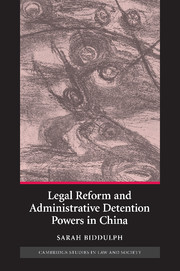Book contents
- Frontmatter
- Contents
- Preface
- Abbreviations
- Part 1 Introduction and conceptual framework
- Part 2 Social order and administrative detention
- 3 Historical antecedents: the 1950s and administrative detention
- 4 Social order, the ‘Hard Strike’ and administrative detention powers
- 5 Revival of administrative detention in the reform era: prostitutes and drug addicts
- 6 Re-education through Labour
- Part 3 Legal reform and its impact on administrative detention
- Part 4 Analysis and conclusion
- Appendix 1 Index of Legislation, administrative regulations, rules, normative documents, Party documents, speeches and cases
- Bibliography
- Index
5 - Revival of administrative detention in the reform era: prostitutes and drug addicts
Published online by Cambridge University Press: 27 July 2009
- Frontmatter
- Contents
- Preface
- Abbreviations
- Part 1 Introduction and conceptual framework
- Part 2 Social order and administrative detention
- 3 Historical antecedents: the 1950s and administrative detention
- 4 Social order, the ‘Hard Strike’ and administrative detention powers
- 5 Revival of administrative detention in the reform era: prostitutes and drug addicts
- 6 Re-education through Labour
- Part 3 Legal reform and its impact on administrative detention
- Part 4 Analysis and conclusion
- Appendix 1 Index of Legislation, administrative regulations, rules, normative documents, Party documents, speeches and cases
- Bibliography
- Index
Summary
INTRODUCTION
In this chapter I trace the parallel development in the reform era of two administrative detention powers: detention for education of prostitutes and clients of prostitutes and coercive drug rehabilitation of drug addicts. These powers were both used by the CCP from around 1949. At that time, these powers, in combination with other measures, were deemed to be so successful that, according to official accounts, the problems of prostitution and drug addiction were eliminated and the powers rendered obsolete. They were both revived at the beginning of the reform era as part of the strategy for dealing with the deterioration of social order and the ‘social vices’ that were identified as part of the fourth ‘high tide’ of crime discussed in chapter 4.
Like RETL, these powers officially form part of the ‘second line of defence’, the ostensible purpose of which is to prevent bad and morally blameworthy conduct from deteriorating further into crime; and which have been used as an adjunct to anti-crime campaigns. Unlike RETL, both powers are directed at very specific targets, were officially abolished and only revived later during the 1970s and 1980s. The reinstatement of these powers took place after the decision was made to rebuild China's legal system. The ways in which these powers have developed from the late 1970s thus provides a very good example of the ways in which the Chinese state has managed legal reform in the context of social order.
- Type
- Chapter
- Information
- Legal Reform and Administrative Detention Powers in China , pp. 152 - 192Publisher: Cambridge University PressPrint publication year: 2007



